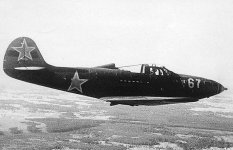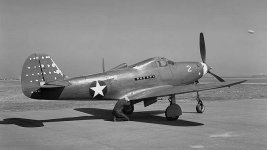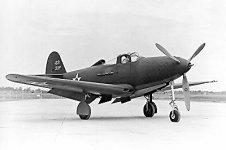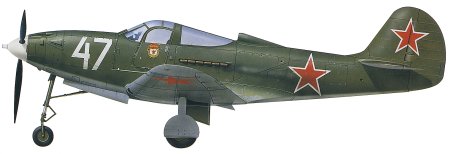
P-39 Airacobra
One of many pre-war innovations explored by the Bell Aircraft Company, the Airacobra appeared to be fast and heavily armed when it was first produced. Its engine, 'buried' in fuselage behind the pilot's seat, was fitted with an extension shaft to the propeller running under the cockpit. A tricycle undercarriage and a 37-mm (1.46 in) cannon were also incorporated.
When war came in 1939, RAF tests revealed that the P-39's overall performance did not match that of British fighters. This and the fact that the Airacobra's unusual systems could prove unreliable caused it to be rejected for service.
In the Pacific, the USAAF had to use any available fighters and the outclassed Airacobras were thrown into war sorties against Japanese during 1942/43. American pilots also flew it during the early combat operations in the Middle East.
Bell improved the aircraft, and when US fighter groups re-equipped with other types many Airacobras were passed to the Red air force, where the 'Little Shaver' was Russian pilot slang for ground strafing, and the P-39 soon earned great respect as a destroyer of German tanks and vehicles.
Airacobra pilots stencilled dozens of tiny stars on their machines to show how adept the 'Lend-Lease' American fighters was at this deadly and dangerous task. The P-39 was also flown by Italian and French pilots during the war.
A revolutionary design, the Airacobra had its engine located behind the pilot and was one of the world's first single-seat fighters to feature a tricycle landing gear. But due to the pace of fighter development in the early 1940s the P-39 was rapidly outclassed. It fought well against heavy odds in the early days of World War II in the Pacific and later won high praise from Russia, which used its cannon to destroy German ground targets.
 |
 |
 |
| Although its performance could not match that of fighters such as Spitfire, the P-39 had respectable figures and good manoeuvrability. |
The Airacobra was the first US single-seat fighter with a nosewheel to enter service. |
The barrel for the mighty 37mm (1.46 in) cannon protruded through the propeller spinner. |
|
P-39 Airacobra (Technical Specification) |
| Role |
Single seat fighter and ground attack aircraft with tricycle undercarriage |
| Manufacturer |
Bell |
| Maximum Speed |
642 kmh (400 mph) |
| Maximum Range |
1,207 km (750 miles) |
| Ceiling |
11,735 meters (38,500 feet) |
Weight
Empty
Maximum Takeoff |
2,566 kg (5,645lbs)
3,702 kg (8,145 lbs) |
Dimensions
Wingspan
Length
Height
Wing Area |
10.36 meters (34 ft)
9.19 meters (30 ft)
3.78 meters (12 ft)
19.79 square meters (213 sq ft) |
| Engines |
One Allison V-1710-63 liquid cooled engine providing 8.95-kW (1,200 hp) |
| Armament |
One 37 mm (1.46 in) plus two 12.7 mm (0.50 cal)
MGs in nose and four 7.62 mm (0.30 cal)
MGs in wings and bombload of up to 227 kg (500 lbs)
|
Photo Gallery
Click here to submit your photo
| Have A Passion For Aircraft? |
Subscribe to our 14 series FREE newsletter
delivered weekly on World War 2 Aircraft factfile... |
| NB:- We hate spam as much as you do, so your email address will NEVER be shared with or sold to anyone else. That's a Guarantee. |
|
|







